About
What is gravity?
How is it made?
How does it work?
Gravity is a very powerful but simple process.
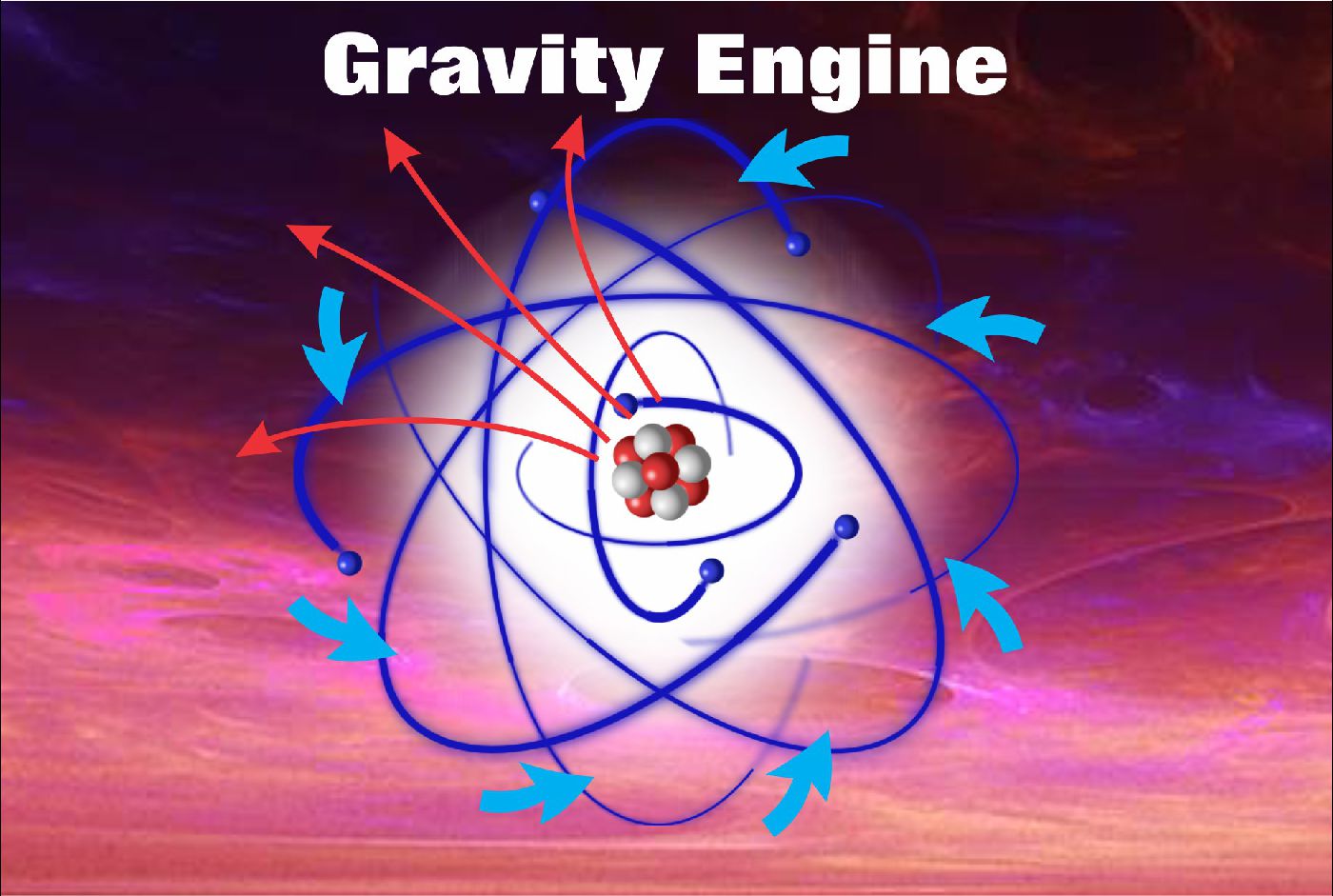

The easiest way to describe gravity is that its like a giant vacuum cleaner that is sucking everything together. The suction force creates a bubble of vacuum pressure around objects which holds them together. Fluid suction is a powerful hydraulic force that collectively has the power to hold galaxies in formation, but it relies on a fluid to achieve this mechanical process. The liquid is Aether which is a very fine fluid smaller than subatomic particles and yet is so vast that it occupies our entire universe.
We see pressure being used to give lift to a wing on an airplane, as well as propulsion to a boat with a propeller using the same force that generates gravity. Gravity is not a special force rather it is the result of vacuum pressure building up around objects (matter). Each atom produces a tiny amount of suction that builds up to a very powerful force as the mass (objects) gets larger. An example of how this works is to compare a large plane can carry 100's of people simply by applying vacuum force equivalent to a babies suction on every inch of the wing. For this process to work vacuum pressure has to work on a liquid or gas and this liquid must be spread throughout space to connect planets and solar systems together.
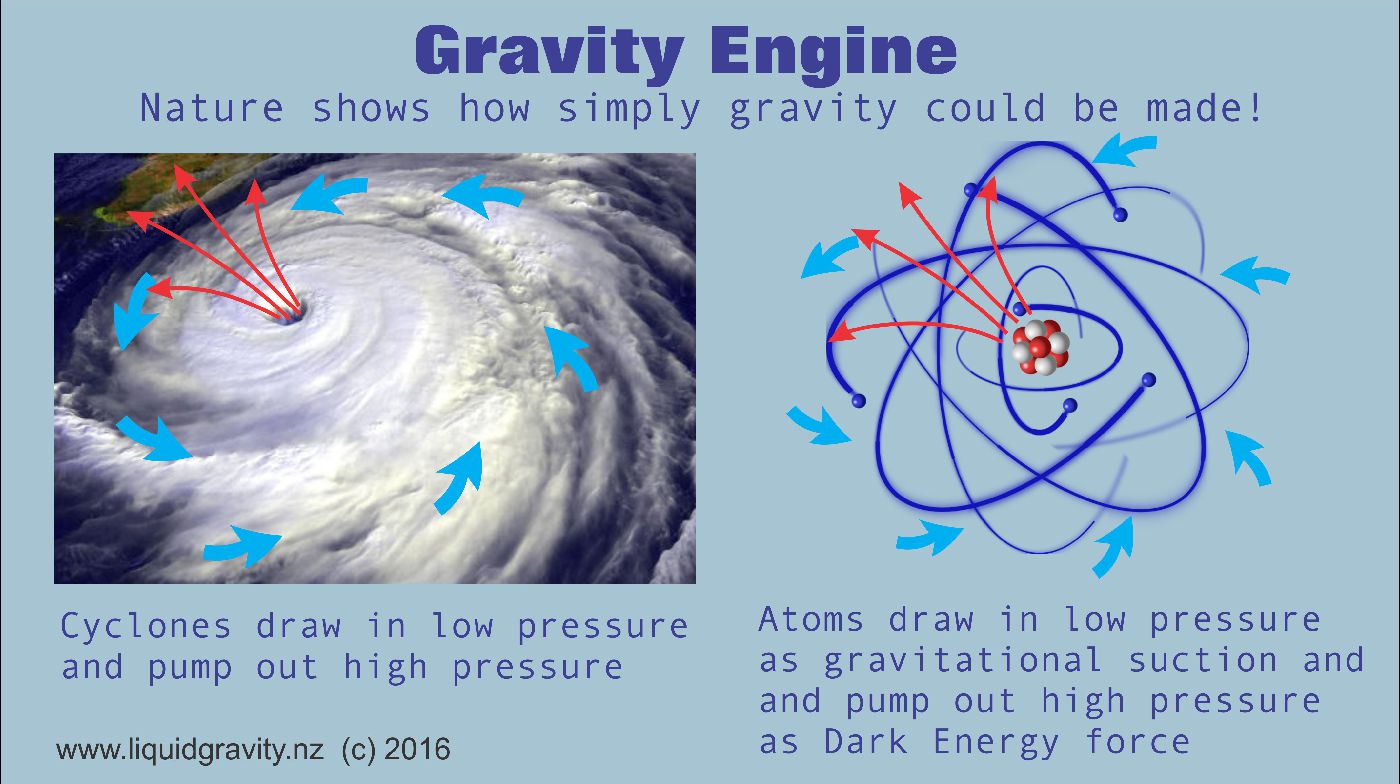
Gravity is simply made by electrons spinning inside atoms which generate a small amount of suction force. This build up of vacuum pressure is known as gravity force.
The input suction force produces a slightly higher compressed output force (Dark Matter Threads) that increases the the collective vacuume force which is gravity force.
We can see from nature how a cyclone by spinning will generate high and low pressure in the atmosphere. A simple and well understood principal we use in airplanes and boats to create lift and propulsion. Atoms have electrons that spin around in a similar way to a fan which build up high and low pressures. The inward suction low pressure is what we experience as gravitational force which progressively builds up as it progresses further into the heart of a planet or star. When it has no where further to go and it escapes back out as high pressure threads known as Dark Matter. Each atom only produces a tiny amount of suction that has only a small suction influence on nearby objects, but each atom contributes to an ever increasing collective pool of vacuum pressure that has huge physical force that can reach distant planets.
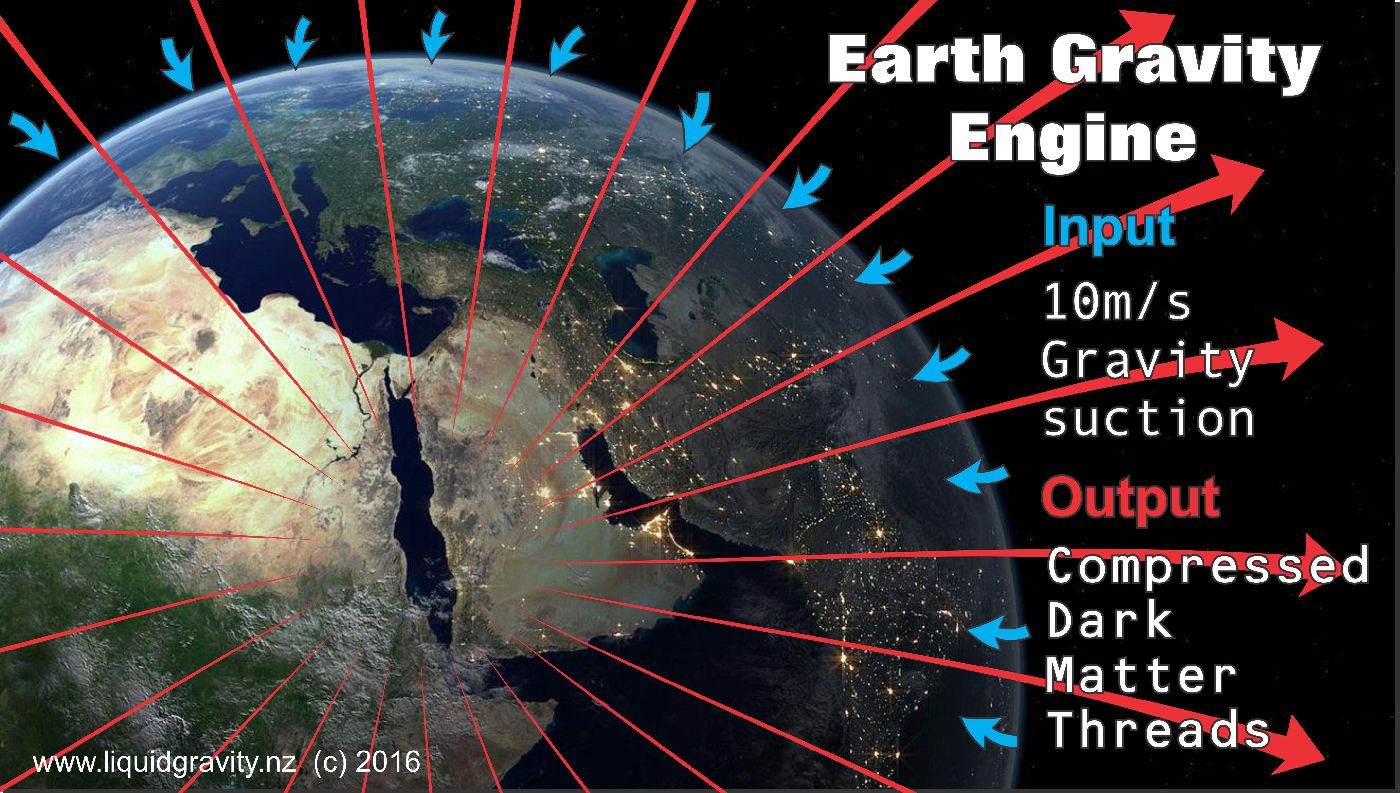
We are literally suctioned onto the planet. by being in a river of Liquid Aether being drawn into the earth. Gravity is part of a bigger cycle that is driven by Atoms inside Matter to produce a flow of Aether that flows through planets and stars and back out into deep space where it inflates the universe.
Think of the earth like a big suction cup that is pulling us by our feet onto the surface of the planet.
It may be hard to believe that as we move around in our daily lives that atoms in our bodies are constantly fighting a battle against 10m/s gravity winds generated by all the earth's atoms all sucking in a tiny amount of pressure.
Some scientist consider that gravity is a primary force that behaves in a similar way to magnetic force where objects are attracted to each other by some mysterious unknown power. Liquid Gravity theory suggests that Gravity isn't a primary force, but is the result of three properties of Liquid Aether
-Aether Vacuum Pressure
-Aether Flow
-Aether Resistance
1/ Aether Vacuum Pressure
The secondary force generated by atoms where the orbiting motion of electrons produces a small amount of vacuum pressure. The Aether Vaccum Pressure accumulates and increases as it approaches matter and continues to increase as it gets deeper inside matter. This Aether Vacuum pressure causes acceleration of objects in free fall because an object always has slightly more vacuum pressure below it than above it which uniformly accelerates all objects at the same rate towards other matter. It process works in the exact opposite way to a wing on an airplane that generates high pressure below and low pressure above to produce lift, so Aether vacuum pressure works the opposite to give objects accelerating fall toward the ground.
2/ Aether Flow
A consequence of Aether pressure that increases around matter. We can detect this Aether Flow using specialised Interferometers. This flow rate does not accelerate as quickly as an object falling through it, but is accelerating at a slower rate relative to the distance away from the outside or inside of the matter. Aether speeds up as it approaches matter and slows down inside matter. Its speed is theorised to be around 10/ms at earth's surface. Different sized planets and stars have different speeds of Aether flow depending on their mass.
3/ Aether Resistance
The result of Matter resisting Aether flow is manifested in weight force. Matter prefers to hold Aether at rest and will resist Aether movement. A heavy object has more resistance to Aether flow than a light object. Gravity weight force is primarily produced by Aether flow that is suctioned through Matter because Aether vacuum pressure pulls Aether into objects. Acceleration through Aether in any direction also produces weight force but due to Matter's resistance the Aether will be pushed around the outside of Matter which is why we experience only gravity weight while we are moving in a constant moving vehicle. You can wave your arms up and down and feel Aether resistance as you slowdown and speed them up. You hands feel heavy when you slow them down , but they become lighter when you speed your arms up.
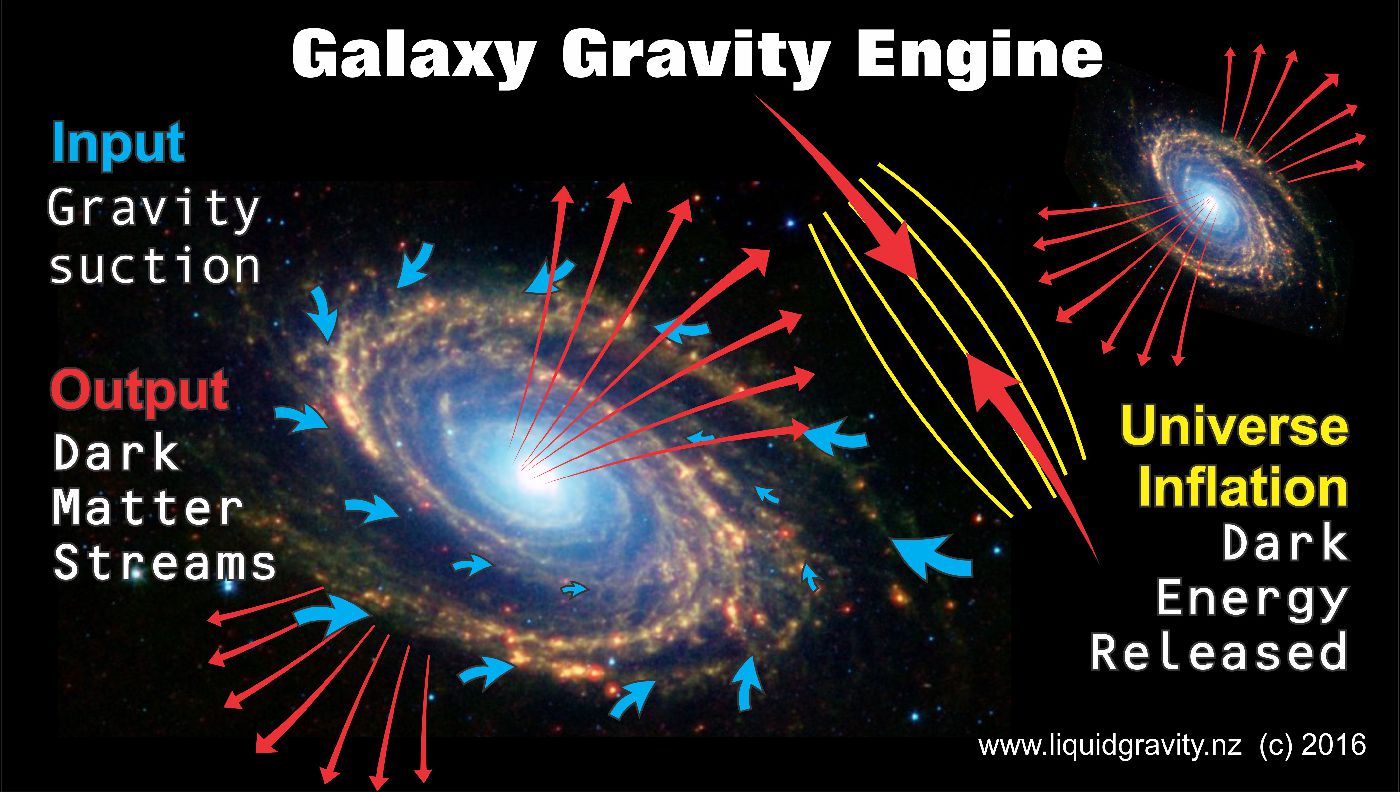
The Energy that we experience as gravity must have its equal and opposite as part of a grater cycle. We see the flow of energy more clearly when we see a galaxy formation in the shape of a Cyclonic disk where we can relate to how the forces flow. In the case of the Galaxy the energy generated from gravity is pushed out through the eye and deep into outer space where it decompresses and inflates the space between the galaxies. These forces have been identified as Dark matter and Dark Energy
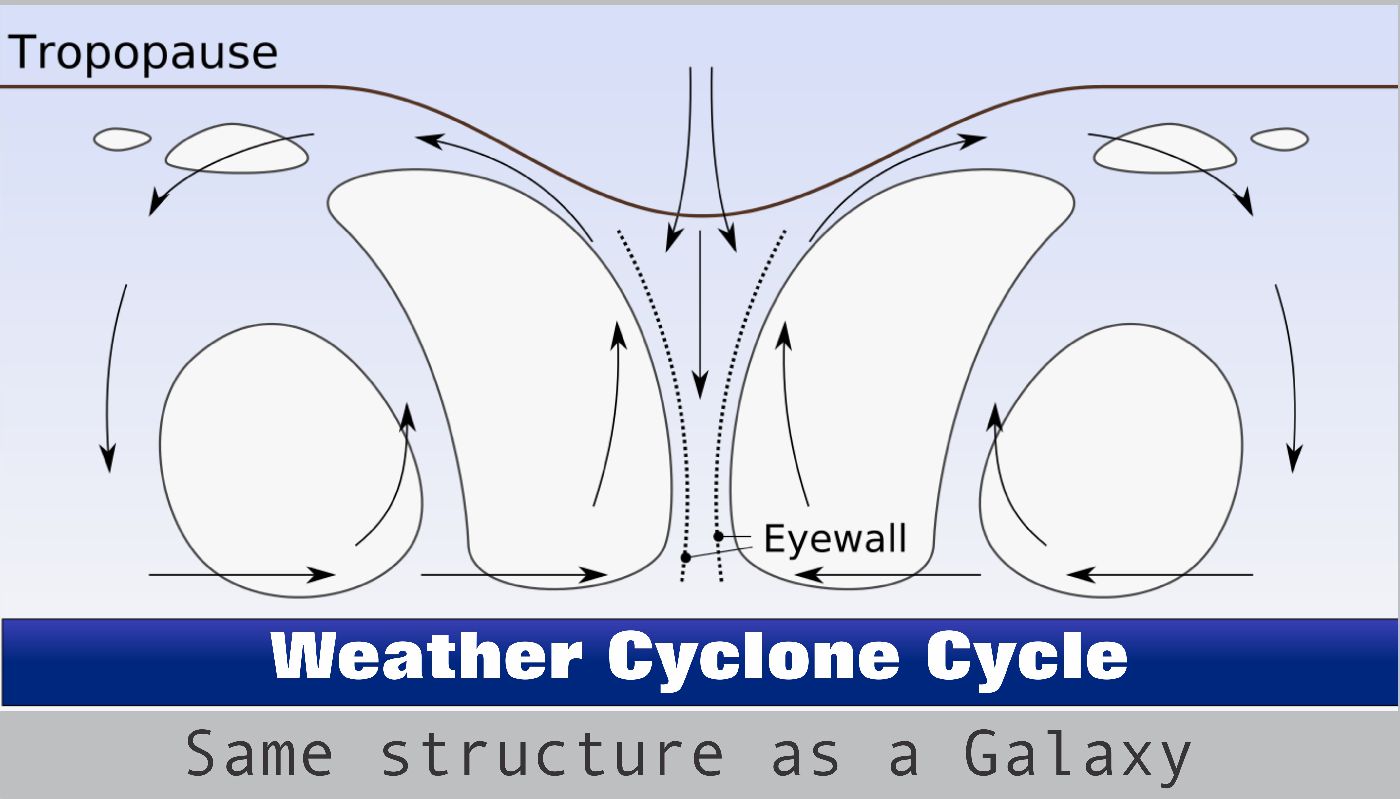
When we see a weather Cyclone we know that there are huge pressure forces building up with Low pressure building around the edges accumulating into a high pressure eye that then pushes the compressed pressure up into the higher atmosphere. A Galaxy shares the exact same structure and has invisible forces acting in the exact same way. Rather than air circulating through a cyclone a galaxy pumps Aether in the form of Dark Matter to produce the same cycle
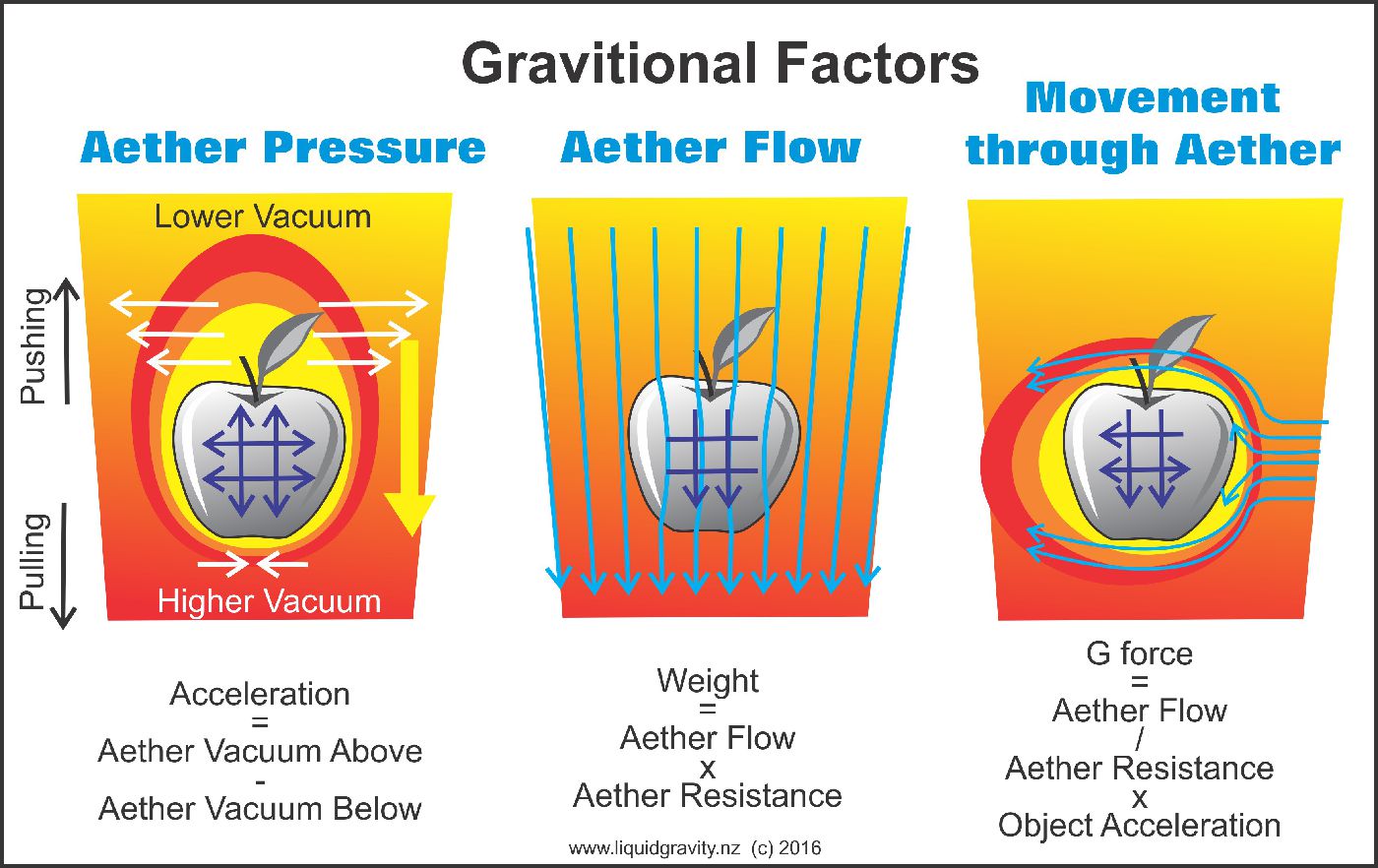
Unlike scientist today searching for one single magic graviton particle, Liquid Gravity describes gravity as having different factors.
The visible affects of gravity are dependant on four factors
Aether Flow:
Our most visible interaction to Aether flow is the measure of weight. Our measure of weight is simply derived by calculating the object's mass resistance to Aether Flow multiplied by Aether Flow rate. We see this illustrated by comparing the same sized object on earth to being on the moon where the different Aether flow rate determines the weight.
Another illustration is holding a balloon underwater in a stream where the weight pressure is felt by the force of the current rather than the physical weight of the balloon.
While Aether Flow can accelerate an object up to the same speed of the Aether Flow rate, it cant accelerate the object beyond that speed, so gravity must possess something more.
Aether Pressure:
Aether Pressure is the vacuum force that builds as a result of atom suction, so the closer to the mass producing the suction, the bigger the increase in suction force.
Our most visible interaction to Aether pressure is by way of gravitational acceleration where an object has higher vacuum pressure below and lower vacuum pressure above which has the affect of accelerating the falling motion. This process is directly opposite to an aircraft wing that has higher pressure under the wing and low pressure above the wing causing it to pull upwards. The only difference is that a falling object will always have higher suction pressure below it no matter how fast its moving which only limits its acceleration by the distance it falls, whereas a wing needs to accelerate forward to increase its lift.
Movement through Aether:
When you are in a car or plane, traveling at a consistent speed you will notice that gravity is consistently holding you on the chair where as you are actually travelling through Aether faster than Aether flow towards the ground, and yet you a not experiencing any Aether Wind (force) in your face. So why do you notice slow moving (35km/k) Aether Flow (gravity) pulling through the floor but no Aether flow in your face as you travel at 500km/h?
The reason is that Aether pulling through your floor is Aether suction that pulls internally through every object, where as when you travel through Aether it will travel around the object like air flow which leaves the inside of the plane affected by the Aether pressure. This difference in behaviour explains why there are different Aether frames. Acceleration through Aether will give you an experience of G-force in your face until you stop accelerating and the resistance of the matter around you equalises the pressure inside your local frame
Aether Frames
Aether Frames are best understood as local time relative to an observer. Einstein has built is theory on the basis of his ideas about Frames called Relativity and Special Relativity. Aether frames connect Einstein's theory of Relativity with Newton's theory of gravity. The distinguishing feature of frames is the movement of light through a frame. Liquid Gravity sees fames as the relative movement of Aether which determines the speed of light within the frame. Aether Frames are determined by Aether moving relative to other Aether Frames which are controlled by gravitational suction, and object movement and resistance. An example of different Aether frames is the inside of an airplane moving at 500km has a different Aether Frame to outside the airplane because the Aether inside the plane is moving sideways relative to the movement of the plane, which would mean light speed would move at the same speed inside each frame which in fact is 500km different relative to the ground frame.
So gravity has its mysteries but once you see the various components of gravity then they all connect in logical formation
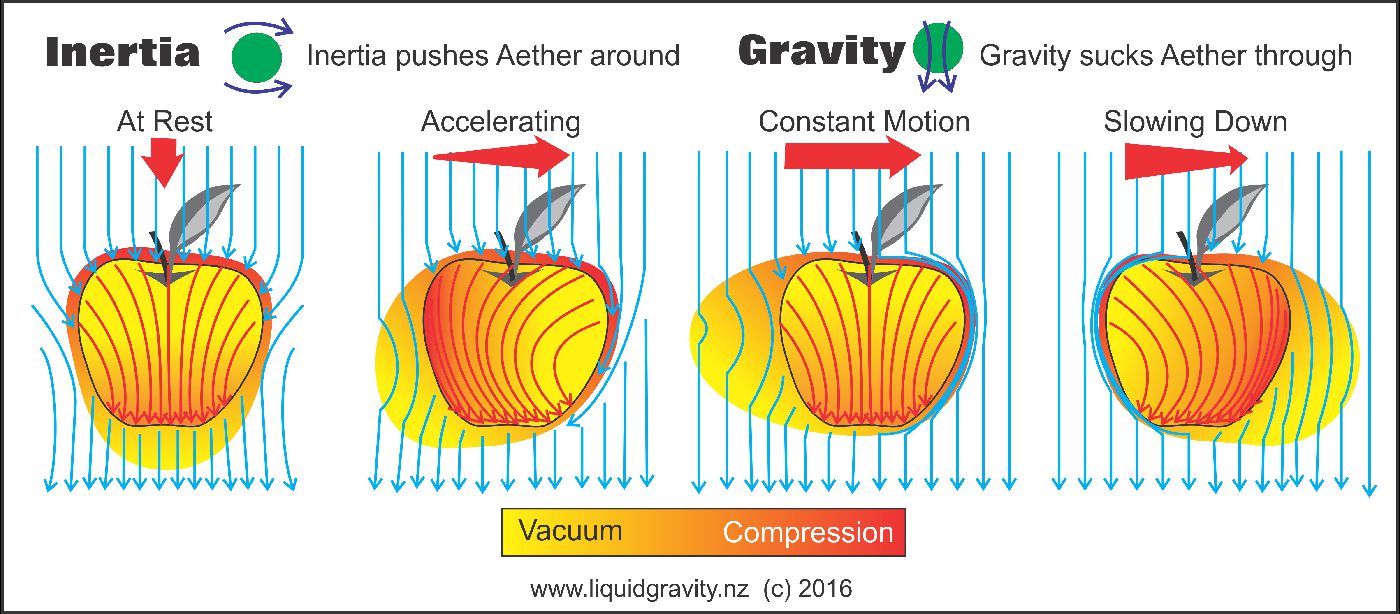
The key difference is that Inertia pushes Aether around and object in motion and Gravity sucks Aether through an object in motion or at rest
Why does gravity accelerate? Todays science explains this phenomenon simply by saying it is a single force that theoretically will continue to accelerate if objects could accelerate away from each other at the same rate. The Liquid Gravity theory suggests that gravitational force has a constant flow rate rather than acceleration rate. However acceleration is achieved through an objects momentum that multiplies on itself. The net result of the effect of gravity is still the same 9.8m/s2
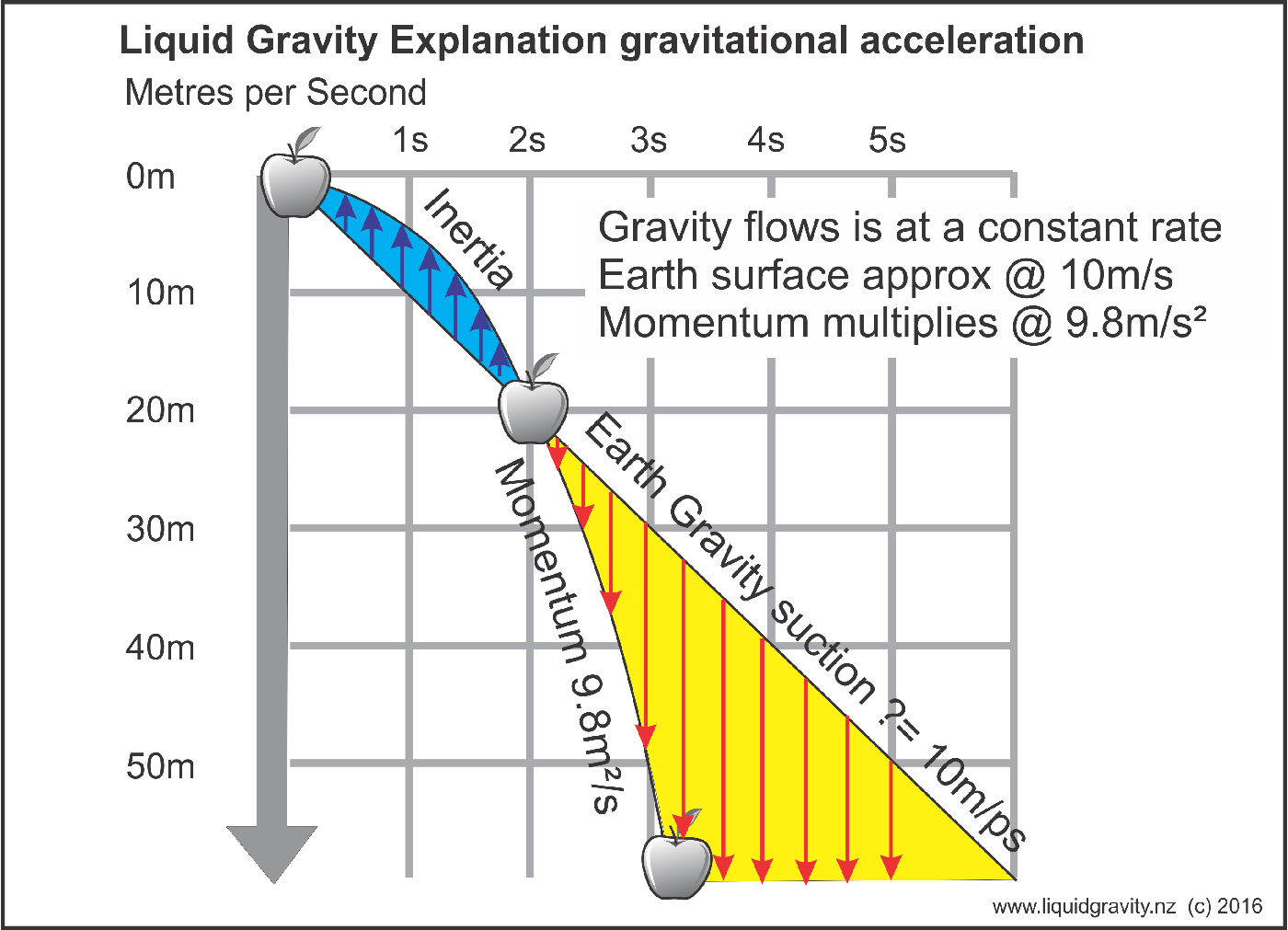
Gravity has been difficult to measure if appears and according to articles on the topic,(read more) Scientists are starting to think that there must be some fundamental mistakes or maybe Gravity isn't a constant force? When you consider measuring gravity in light of Liquid Gravity theory you soon realise that there are a lot of contributing factors that make up gravitational force. In the past the gravitational measurements have been done primarily with lead balls without too many changes and these tests have produced similar but slightly different results. Now with Liquid Gravity's latest Cavendish experiment using a flat square washer and square block of mass which show huge differences in outcomes based on the different orientations. This demonstrates the huge fundamental changes scientist have to do to measure the gravitational constant.

The four factors of gravitational acceleration
Liquid Gravity sees gravitational force as a constant force rather than an accelerating force. Its strength is determined by the size of the mass, its distance and other factors. The effect of acceleration is a consequence of compounding momentum. So there are four district stages of gravitational acceleration.
1-Inertia, 2-Force, 3-Momentum, 4 Acceleration
The process is like a person running at 10km/h and jumps onto a bus while still running. The bus is driving at 10km/h and the bus drives onto the ferry still moving, which sails at the speed of 10km/h the ferry then goes down a river flowing at 10kmh, so we now see the rate of acceleration of the person running from 10kmph to 40km/h without changing the flow rate of 10kmh
- Stage 1 is “Inertia” which an object experiences as it is hit by a constant gravitational force as it moves from its standing still stage to moving at the same rate of the gravitational force.
- Stage 2 ‘Force’ The object is now moving almost as fast as the rate of earths Gravitational flow
- Stage 3 ‘Momentum’ The Object isn't increasing in speed , in fact it begins to slow down as it has built up momentum which will eventually diminish as it meets resistance.
- Stage 4 ‘Acceleration’ This whole process, Inertia, Force, and Momentum is collectively moving and now repeats itself over and over which multiplies its speed and creates a compounding acceleration.
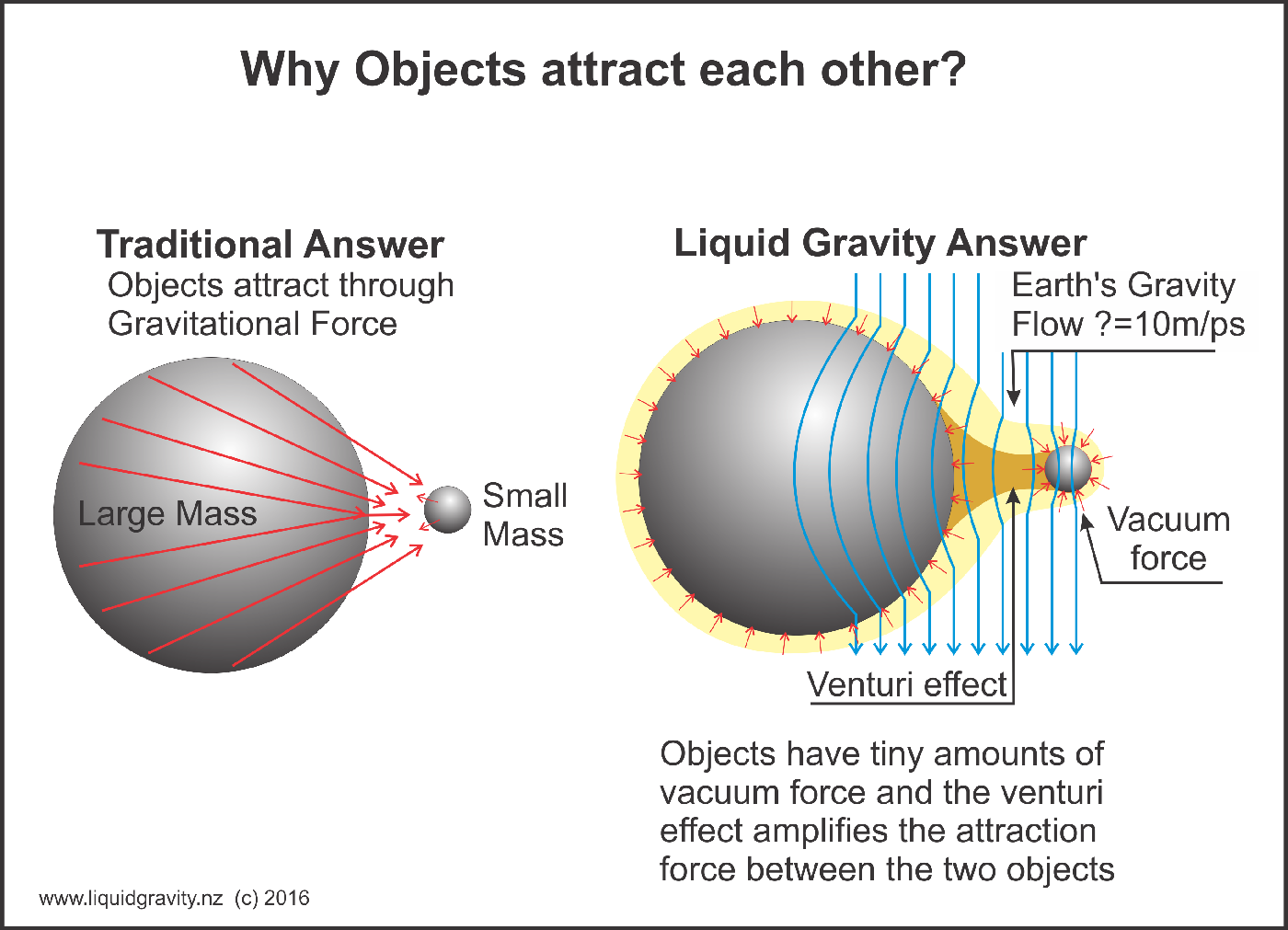
Traditional teaching says that gravity is a primary force based on the sum of the two masses and their distance apart. See how we can break those laws just by changing the orientation of the objects that changes the response . This shows that Gravity doesn't behave like Newton's has predicted and that there are other factors that define gravitational attraction. These Factors are:
1. Earths Gravitational Flow
2. Object's Vacuum Force
3. Surface area and mass
4. Distance apart
5. Venturi effect
These new gravitational attraction factors were discovered during testing on the Cavendish Rig using flat washers and getting different results when the washer was in the vertical position, compared to being in the flat horizontal position. Also by moving them to different heights resulted in acceleration or slowing of movement. These results are consistent with the effects of a Venturi force that responds to the movement of fluids through a gap See further details about the Cavendish Tilt Washer experiment
Three experiments that break Newton's Laws revel how gravitational attraction really works using simple washer and square mass in the traditional Cavendish Experiment rig.
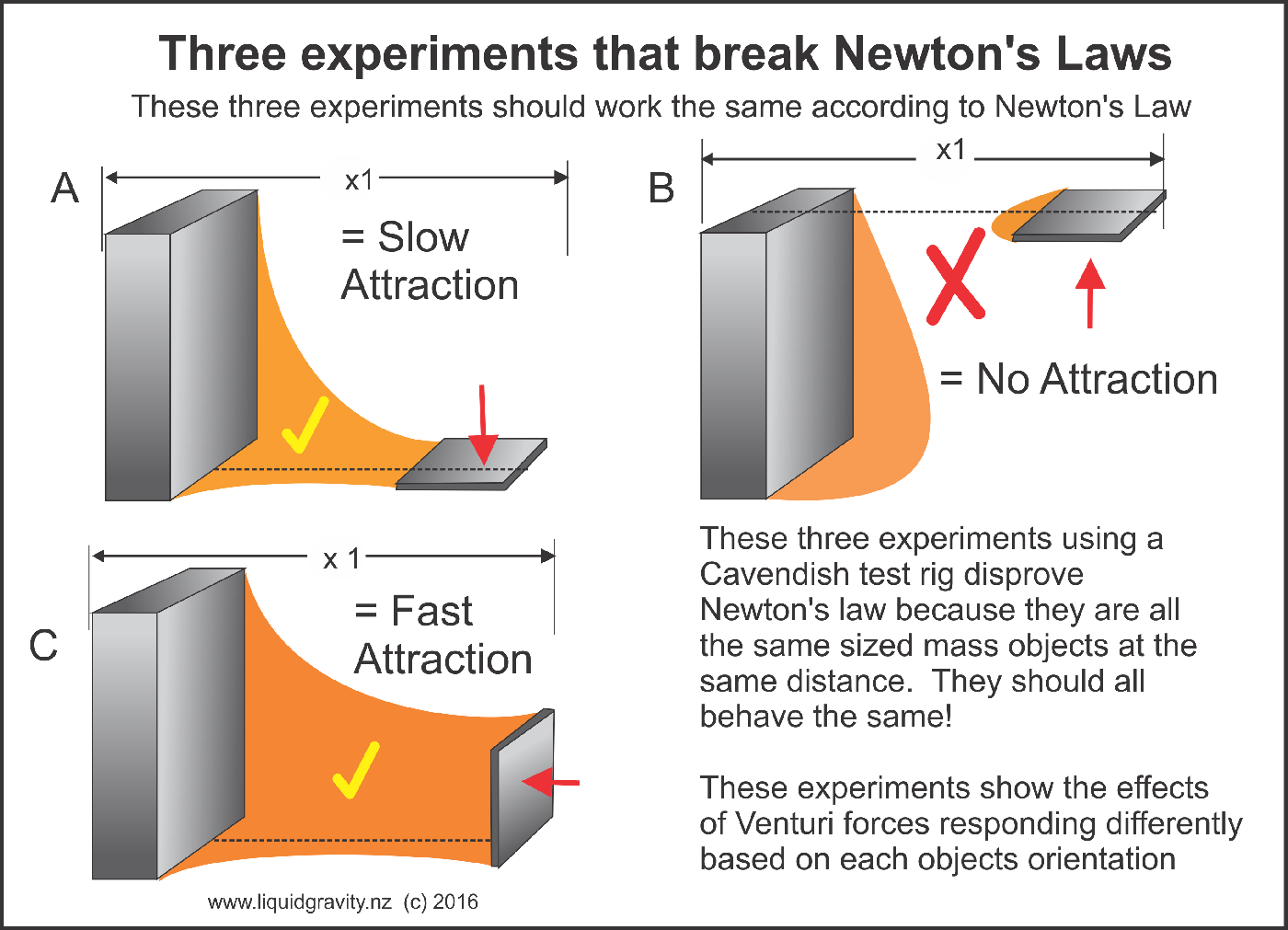
According to Newton, these results should all be the same with the same mass and same distance, so obviously Newton's law isn't working. What this experiment revels is that Liquid Gravity is working and using 4 factors that make up object attraction.

SHARE THIS PAGE!